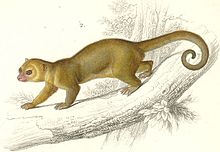From Wikipedia, the free encyclopedia
| Kinkajou | |
|---|---|
 | |
| Scientific classification | |
| Kingdom: | Animalia |
| Phylum: | Chordata |
| Class: | Mammalia |
| Order: | Carnivora |
| Family: | Procyonidae |
| Genus: | Potos Geoffroy Saint-Hilaire & Cuvier, 1795 |
| Species: | P. flavus |
| Binomial name | |
| Potos flavus (Schreber, 1774) | |
 | |
| Kinkajou range | |
The kinkajou (Potos flavus) is a rainforest mammal of the family Procyonidae related to olingos, coatis, raccoons, and the ringtail and cacomistle. It is the only member of the genus Potos and is also known as the "honey bear" (a name that it shares with the sun bear). Kinkajous may be mistaken for ferrets or monkeys, but are not closely related to either. Native to Central America and South America, this mostly frugivorous, arboreal mammal is not an endangered species, though it is seldom seen by people because of its strict nocturnal habits. However, they are hunted for the pet trade, for their fur (to make wallets and horse saddles) and for their meat. The species has been included in Appendix III of CITES by Honduras, which means that exports from Honduras require an export permit and exports from other countries require a certificate of origin or re-export. They may live up to 40 years in captivity.
...Kinkajous spent most of their life in trees, to which they are particularly well adapted. Like raccoons, kinkajous' remarkable manipulatory abilities rival those of primates. The kinkajou has a short-haired, fully prehensile tail (like some New World monkeys), which it uses as a "fifth hand" in climbing. It does not use its tail for grasping food. It can rotate its ankles and feet 180°, making it easy for the animal to run backward over tree limbs and climb down trees headfirst. Scent glands near the mouth, on the throat, and on the belly allow kinkajous to mark their territory and their travel routes. Kinkajous sleep in family units and groom one another.[ While they are usually solitary when foraging, they occasionally forage in small groups, and sometimes associate with olingos (which are also frugivorous).
A nocturnal animal, the kinkajou's peak activity is usually between about 7:00 PM and midnight, and again an hour before dawn. During daylight hours, kinkajous sleep in tree hollows or in shaded tangles of leaves, avoiding direct sunlight.
Kinkajous breed throughout the year, giving birth to one or occasionally two small babies after a gestation period of 112 to 118 days.
Kinkajous are sometimes kept as exotic pets. They are playful, generally quiet, docile, and have little odor. However, they can occasionally be aggressive. Kinkajous dislike sudden movements, noise, and being awake during the day. An agitated kinkajou may emit a scream and attack, usually clawing its victim and sometimes biting deeply. In 2011, the Centers for Disease Control and Prevention reported that pet kinkajous in the United States can be carriers (fecal-oral route) of the raccoon roundworm Baylisascaris procyonis, which is capable of causing severe morbidity and even death in humans, if the brain is infected. In Peru pet kinkajous are commonly referred to as "lirón". The lirón is often described as a "bear-monkey" or "bear-monkey hybrid".



No comments:
Post a Comment